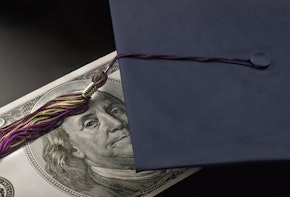On January 11, the U.S. Supreme Court will hear oral arguments in Friedrichs v. California Teachers Association. The case pits the right of public employees to band together and form effective unions to pursue the common interests of workers against the free speech rights of dissenting public employees to abstain from funding collective bargaining efforts with which they disagree.1 A decision by the Court against the teachers association could not only significantly weaken public sector unions, but also endanger the nation’s core democratic values.
In the suit, a public school teacher, Rebecca Friedrichs, argues that a state law requiring her to pay fees to the California Teachers Association (CTA) violates her First Amendment rights not to subsidize speech to which she objects. The CTA counters that in order to promote peaceful and orderly labor relations, and as a matter of basic fairness, the state may require Friedrichs to cover the costs of collective bargaining agreements, from which she benefits, preventing her from being a “free rider.”
Union supporters worry that a decision in Friedrichs’ favor could devastate public sector unions across the nation. These unions, whose numbers were once small compared to the vibrant private sector union movement, now represent nearly a majority of unionized workers.2 The one bright spot in an otherwise deteriorating American labor movement, public sector unions are now under extraordinary legal and political assault. More broadly, many progressives see the Friedrichs case as an effort to defund the American left, given the financial support public sector unions provide a variety of liberal causes, from civil rights to raising the minimum wage.3
This report highlights an additional problem that should concern people across the political spectrum: defunding public sector unions could deal a substantial blow to a critical driver of American democracy.
Public sector unions promote democratic values and practices in a variety of ways. They serve as a check on arbitrary government power and help sustain middle-class wages and benefits; serve as schools of democracy for workers; and, in the case of teacher unions, help support a public school system that promotes democratic values. These larger interests should enter into the calculus the Supreme Court uses to weigh free speech rights against state interests.
Indeed, the whole idea of unionism is based on basic democratic values. The fundamental idea that duly-elected union leadership has the right to collect dues and advocate as the majority of workers wants is analogous to a democracy’s right to impose taxation in order to promote the common good. The 1935 National Labor Relations Act embodied this democratic vision. Section 1 provides: “It is declared to be the policy of the United States to eliminate the causes of certain substantial obstructions to the free flow of commerce and to mitigate and eliminate these obstructions when they have occurred by encouraging the practice and procedure of collective bargaining and by protecting the exercise by workers of full freedom of association, self-organization, and designation of representatives of their own choosing, for the purpose of negotiating the terms and conditions of their employment or other mutual aid or protection”4 (emphasis supplied). Subsequent state laws governing collective bargaining for public sector employees were modeled on the NLRA’s vision.
The report proceeds in four parts. Part I analyzes the claims in Friedrichs under the current framework of balancing envisioned by the Supreme Court, and concludes that fair share fees are justified. Part II broadens the discussion to consider the state’s powerful interest in promoting institutions that strengthen American democracy. Part III considers an objection raised by supporters of Friedrichs: that public sector unions will do just fine if they lose the Friedrichs case. Part IV concludes.
Balancing First Amendment Rights against the State’s Interests
The current legal framework in which courts weigh cases such as Friedrichs is narrowly constrained, balancing the free speech rights of dissenting union members against the state’s interests in promoting stable labor relations with its public employees.
In the 1977 case of Abood v. Detroit Board of Education, the U.S. Supreme Court reached a sensible compromise that properly balanced these two sets of interests by splitting union dues into two categories: those that support political speech, and those that support bread–and-butter collective bargaining. Because the First Amendment’s free speech clause provides a right to not be compelled by the state to subsidize speech with which one disagrees, dissenting public employees cannot be required by the state to join a union, or to subsidize the union’s political and lobbying efforts to promote certain positions of public concern.5
On the other hand, the Court recognized that the state, as an employer, has an interest in promoting harmonious labor relations. To discourage the formation of multiple unions with competing claims, the state has an interest in facilitating a single union negotiating on the behalf of all workers, whether or not individual employees choose to be a member of the union. Under an exclusive bargaining arrangement, the union has a duty to represent members and nonmembers alike. Accordingly, the Court held, the state may prevent employees from being “free riders” by compelling contribution to that portion of union membership dues that underwrite the cost of collective bargaining over issues such as wages and benefits.
More recently, in Harris v. Quinn (2014), the Supreme Court was asked to apply the Abood principle to unionized home care workers. The Supreme Court rejected that extension, finding that home care workers, although paid with public funds, were only “partial public employees.” They work for individual patients in private homes and answer mostly to the patients for their work. The Supreme Court created a new test, as scholar Catherine Fisk notes, which suggests that fair share fees can only be justified when “the cited benefits” require imposition of such fees. “No such showing” was made in Harris, the justices held, noting that under Illinois law, the union negotiated a limited number of issues and had no role in enforcing contracts for nonmembers.6 Although Harris sustained the 1977 Abood holding, a majority hinted that it might be willing to overturn Abood in a future case.7
In Friedrichs, the petitioner explicitly seeks to have the Supreme Court overrule the longstanding Abood compromise.8 That would be a serious mistake, for reasons outlined below.
Current Rules Balance Free Speech Rights
The U.S. Supreme Court has long recognized that First Amendment rights extend beyond the right to speak to include the right not to be compelled to subsidize speech to which an individual objects. The lawyers for Friedrichs invoke Thomas Jefferson’s statement “to compel a man to furnish contributions of money for the propagation of opinions which he disbelieves is sinful and tyrannical.”9 The state cannot require that, as a condition of employment, public employees must contribute to an ideological cause they may oppose.
Friedrichs tries to argue that the distinction between political speech and collective bargaining for public sector unions outlined in Abood is illusory; that because collective bargaining over wages and benefits impacts state budgets, it is inherently political speech. But respondents point out that if this were true—that collective bargaining is a form of political speech—how could it be legal for states to ban it among public employees, as several states currently do?
Moreover, the Abood Court noted that dissenting public employees are still free to express their disagreements with the union publicly and vocally. A “public employee who believes that a union representing him is urging a course that is unwise as a matter of public policy is not barred from expressing his viewpoint.”10 And, of course, if teachers such as Friedrichs are upset with union leadership, they can seek to have leaders ousted through periodic democratic elections of officers, or even run for office themselves.
Countervailing State Interests Recognized in Abood
Free speech rights are never absolute. Jefferson’s statement about compelled contributions, for example, cannot be taken literally. For instance, the government may, in fact, compel taxation from an individual who is opposed to the war in Afghanistan, and then use those funds to engage in speech to recruit soldiers for the war effort. Free speech rights must always be balanced against other considerations.
In the case of public sector unions, the Abood Court noted the state has two major interests. The opinion, written by Potter Stewart, an Eisenhower appointee, identified one as labor peace and workplace stability, and the other as reducing the risk of “free ridership” and unfairness.11
In the United States, a single union normally represents all employees in order to promote “labor peace.” “The principle of exclusive union representation,” the Court noted, “is a central element in the congressional structure of industrial relations.” The National Labor Relations Act—and many state collective bargaining laws—provide for a single representative to avoid “the confusion that would result from attempting to enforce two or more agreements specifying different terms and conditions of employment.” The Court noted that the arrangement also “prevents inter-union rivalries from creating dissension within the workforce and eliminating the advantages to the employer of collectivization.” Finally, the Court observed, exclusive union representation “also frees the employer from the possibility of facing conflicting demands from different unions, and permits the employer and a single union to reach agreements and settlements that are not subject to attack from rival labor organizations.”12
In the context of public employee unions, the Court noted, “confusion and conflict” could reign, for example, if rival teachers unions held different positions on issues such as “class hours, class sizes, holidays, tenure provisions,” and the like.13
A second, related, state interest is to prevent what is known as the “free rider” problem in cases of collective action. Because of exclusive representation, unions have a duty “fairly and equitably to represent all employees . . . union and non-union.” Given this arrangement, in which employees benefit from collective bargaining whether they are union members or not, a classic “free rider” issue arises, the Court noted, whereby employees could “refuse to contribute to the union while obtaining the benefits of union representation that necessarily accrue to all employees.”14
Free rider problems exist in many organizations. Why donate to a religious institution if you can still attend and enjoy services whether or not you pay? To counter this, some groups can provide “special advantages” to backers—a leadership position in the church, for example. Unions cannot take this approach, however. As Justice Kagan noted in Harris v. Quinn, because “the law compels unions to represent—and represent fairly—every worker in the bargaining union, regardless whether they join or contribute to the union,” the collective action problem is “of far greater magnitude than in the typical interest group.”15 She referenced Justice Antonin Scalia’s opinion in an earlier decision, making this point: “where the state creates in the nonmembers a legal entitlement from the union, it may compel them to pay the cost.”16 This principle, “there is no free lunch,” is something conservatives usually understand well.
According to the counsel for Friedrichs, annual dues to the CTA amount to approximately $1,000 per teacher, of which nonmembers receive a refund of roughly $350 to $400 for expenses unrelated to collective bargaining.17 In other words, Friedrichs is happy to accept increases in wages and benefits the union negotiates hard to win, but does not want to pay the $600 to $650 per year that other members contribute in order to make those wage gains possible. Will she give back her raises, forgo health care benefits, give up the right to pursue grievances, and agree to teach larger classes that the union negotiated? The amicus brief of the American Federation of Teachers and the American Association of University Professors put it well: there is no “constitutional right to a free ride.”18
Promoting Democracy Should Be Considered in Balancing Free Speech and State Interests
In balancing the rights of free speech and state interests, Abood came to the correct conclusion—free speech rights can sometimes be curtailed to serve state interests in labor peace and avoiding free ridership. But these are only a subset of state interests. Indeed, the Abood court substantially understated the interests of states in preserving fair share fees. For example, amici in the case, such as the National Women’s Law Center and seventy other civil rights groups, note that there are myriad ways in which labor unions generally—and public sector unions specifically—improve the conditions of minorities and women, a vitally important state interest.19
All unions—including, and perhaps especially, public sector unions—also contribute to one of the most important foundational interests of the state: democracy. And they do this in many different ways. Unions are critical civic organizations that serve as a check on government power. They are important players in promoting a strong middle class, upon which democracy depends. They serve as schools of democracy for workers. And teacher unions, in particular, help ensure that our educational system is sufficiently funded to teach children to become thoughtful and enlightened citizens in our self-governing democracy.
Democracies Need Unions to Serve as a Check on Government Power
Alexis de Tocqueville famously marveled at the thriving civic associations that keep American democracy vitalized; and for the past century, unions have been a critical part of that framework. Recognizing the important role of unions in liberal democracies, the 1948 Universal Declaration of Human Rights provides in Article 23 that “Everyone has the right to form and join trade unions for the protection of his interests.”
In 1980, President Ronald Reagan championed the role of Polish unions in challenging dictatorial rule by the Communist Party. Reagan declared in a Labor Day speech that year, “where free unions and collective bargaining are forbidden, freedom is lost.” Albert Shanker, the legendary president of the American Federation of Teachers from 1974 to 1997, saw a pattern in authoritarian regimes. “There is no freedom or democracy without trade unions,” he noted. “The first thing a dictator does is to get rid of the trade unions.”20 Public sector unions, in particular, have played an important role in bringing down dictators in countries such as Chile.21 In free societies across the globe, from Finland to Japan, the rights of teachers and other public sector employees to unionize are well established. Indeed, when the United States attempts to plant the seeds of democracy in other countries, free trade unions—for private and public sector workers alike—are critical elements of what we advocate.
If such unions are to have the capacity to wield influence, they cannot be starved of the fees from workers necessary to play that role.
Democracies Need a Strong Middle Class to Avoid Plutocracy
Going back to Aristotle, it has been recognized that democracies are more likely to thrive when a vibrant middle class can support them.22 Large inequalities of wealth can undermine democracy. As philosopher Sidney Hook observed, “It is possible for people to be politically equal as voters, yet so unequal in educational, economic, and social opportunities, that ultimately, even the nature of the political equality is affected.”23
In highly unequal societies, large income gaps can give wealthy interests an outsized role in electing officials. Theodore Roosevelt warned of the dangers of having “a small class of enormously wealthy and economically powerful men, whose chief object is to hold and increase their power.”24 More recently, Nobel Prize–winning economist Michael Spence told the New York Times that we have seen “an evolution from one propertied man, one vote; to one man, one vote; to one person, one vote; trending to one dollar, one vote.”25
Strong unions helped build the middle class in America after the Great Depression, and continue to have a positive effect on ameliorating extreme inequalities of wealth. By bargaining for fair wages and benefits, unions in the public and private sector help foster broadly shared prosperity. Research finds, for example, that unions compress wage differences between management and labor. According to one study, “controlling for variation in human resource practices, unionized establishments have an average of 23.2 percentage point lower management-to-worker pay ratio relative to non-union workplaces.”26
By the same token, as the Center for American Progress’s David Madland has vividly illustrated, the decline in union density in the United States between 1969 and 2009 has been accompanied by a strikingly similar decline in the share of income going to the middle class (the middle three-fifths of the income distribution; see Figure 1). The middle class is hollowing out: in 1971, 61 percent of Americans were middle class, but a December 2015 Pew Research Center report found that a slight majority of Americans now live in low- or upper-income households.27 Although there are many reasons for middle-class wage stagnation—including globalization and the rise in technology—Lawrence Mishel of the Economic Policy Institute finds that the decline in union bargaining power is “the single largest factor suppressing wage growth for middle-wage workers over the last few decades.” The International Monetary Fund, likewise, has linked decline in unions worldwide with rises in income inequality.28
Figure 1.
International studies also connect the relatively low levels of U.S. union density (when compared with other nations) and the higher level of economic inequality found in the United States. According to a 2011 analysis by the Center for Economic and Policy Research looking at twenty-one wealthy nations, nine countries had more than 80 percent of their workers covered by collective bargaining agreements; nine had between 30 and 80 percent covered; and just three—the United States, Japan, and New Zealand—had coverage rates below 20 percent. Using data from the Central Intelligence Agency’s World Factbook on levels of income inequality, my colleague Moshe Marvit and I demonstrate in Why Labor Organizing Should Be a Civil Right that the three nations with the lowest collective bargaining coverage also were among the four countries with the highest degrees of income inequality, as measured by the Gini coefficient.29 Defunding public sector unions will only accelerate the extreme economic inequality that threatens our political democracy.
Unions Are Needed to Serve as Schools for Democracy
Civic organizations that are run democratically can be an important mechanism for acculturating citizens to the inner workings of democracy. Unions are among the most important of these organizations, bringing together rank and file workers from a variety of ethnic, racial, and religious backgrounds, and serving as what Harvard sociologist Robert Putnam calls “schools for democracy.” Union members learn skills that are essential to a well-functioning democracy: how to run meetings, debate one another, and organize for political action.30
Labor unions can also help create a culture of participation among workers. Being involved in workplace decisions and the give and take of collective bargaining, voting on union contracts, and voting for union leadership have all been called important drivers of “democratic acculturation.”31
In addition, union members routinely engage in civic activities, such as staffing phone banks and canvassing voters door to door. This involvement can boost civic participation among union members and nonmembers alike. One study found that for every one-percentage-point increase in a state’s union density, voter turnout increased between 0.2 and 2.5 percentage points. In a presidential election, a ten-percentage-point increase in union density could translate into 3 million more voters.32
Democracies Need Well-Educated Citizens, Which Teachers Unions Help Produce
Democracies need well-educated citizens, and one important subset of public sector unions—those representing teachers—play a vital role in promoting that goal. Of the 17 million state and local government employees in 2010, 6.9 million were teachers.33
Most contemporary political rhetoric emphasizes the importance of education in creating a skilled workforce. But the original purpose of public education was to provide an educated citizenry that could make our ongoing experiment in self-governance work. Democracy requires a thinking people who are not easily swayed by demagoguery. Thomas Jefferson argued that public schooling was necessary “to ensure that citizens would know how to protect their liberty.” Nineteenth century educator Horace Mann, widely seen as the father of public education, put it more colorfully: “A republican form of government, without intelligence in the people, must be, on a vast scale, what a mad-house, without superintendent or keepers, would be on a small one.” At root, the idea of self-governance requires an educated citizenry because the people themselves rule. All nations, as historian Paul Gagnon noted, provide an excellent education to “those who are expected to run the country,” and that quality of education “cannot be far from what everyone in a democracy needs to know.”34
In the Friedrichs case, the lawyers for the petitioner try to make the case that teachers unions have a “detrimental” effect on education. Citing the Hoover Institution’s Terry Moe, the attorneys for Friedrichs argue, “there is strong evidence that, as union-negotiated agreements become denser with rules and procedural protections, student achievement falls, especially among minority students.”35 Critics such as Jay Greene of the University of Arkansas compare teacher unions to special interests like the Tobacco Institute. But the difference, of course, is that the latter is dedicated to getting more children addicted to deadly cigarettes, while the former represent rank and file teachers who are trying to help teach children to read and understand math and science.36
As the amicus brief of the American Federation of Teachers and the American Association of University Professors points out, states with “fair share” collective bargaining provisions have higher academic performance on average than those who do not. Fourth grade math proficiency is 9 percent higher, while reading proficiency is 13 percent higher; and in eighth grade, by which time students have spent more time in school, the difference is more pronounced: 16 percent higher in both math and reading proficiency.37 (See Figure 2.)
Figure 2.
Of course, there are lots of other factors, such as poverty, that influence a state’s student achievement levels. But careful studies that seek to control for those additional factors tend to find higher achievement in states with strong teacher unions. A review by sociologist Robert Carini concluded that “there is an emerging consensus in the literature that teacher unionism favorably influences achievement for most students, as measured by a variety of standardized tests.”38
Carini’s 2002 review of seventeen widely cited studies observed that twelve found positive effects, and five found negative effects (see Figure 3). Moreover, the twelve concluding positive results were more methodologically rigorous than the five that found negative effects, because they were more likely to look at student level data (rather than using state or district averages) and to control for more variables.39
Figure 3.
Union representation is plausibly connected to higher achievement, as Leo Casey of the Albert Shanker Institute has noted, because “the working conditions of teachers are, in significant measure, the learning conditions of students, and so, improvements in the working lives of teachers generally translate into improvements in the education of students.”40 Before Albert Shanker and his colleagues in New York City began bargaining collectively for teachers in the early 1960s, teachers were paid less than people who washed cars for a living.41 Subsequently, unions began bargaining for higher teacher salaries, which are likely to attract better candidates, and smaller class sizes, which can improve student learning. Unions also seek greater voice for teachers in school decision making, which can reduce teacher turnover.42
Indeed, one could argue that teachers unions provide a healthy enhancement to democratic decision-making on education policy because teachers, as much as any other group in society, serve as powerful advocates for those Americans who cannot vote—school children. As journalist Jonathan Chait has noted, politicians—who have short-term horizons—are prone to under-investing in education, and teachers unions “provide a natural bulwark” against that tendency. Since most voters do not have children in the public school system, those parents who do need political allies have their concerns heard.
The interests of teachers and their unions do not always coincide with those of students, but on the really big issues, such as overall investment in education, the convergence of interests is strong. And evidence suggests that the alliance is working.
In general, American society consistently under-invests in children outside of schools, compared with other leading democratic societies. According to the Organisation for Economic Co-operation and Development (OECD), the child poverty rate in the United States is 21.6 percent, the fifth highest among the forty member-nations. Only Turkey, Romania, Mexico, and Israel have higher child poverty rates. Put differently, the United States is in the bottom eighth in preventing child poverty.
By contrast, when the interests of children are represented by and connected to the interests of teachers—as they are on the question of public education spending—the United States ranks close to the top third. Among thirty-nine OECD nations, the United States ranks fourteenth in spending on primary and secondary education as a percentage of gross domestic product.43 There is little doubt that, without the voice of teachers, the United States would under-spend on public education as well.
In her dissent in Harris v. Quinn, Justice Elena Kagan made a parallel argument about home care workers. Patients suffer when low wages induce workforce shortages and high turnover. “The individual customers are powerless to address those systemic issues,” Kagan wrote, but the unionization of home-care assistants helped doubled wages over ten years.44
There is a final, important way in which teacher unions can promote democratic citizenship: by modeling workplace democracy for children. In schools where educators have a voice, as my colleague Halley Potter and I noted in A Smarter Charter: Finding What Works for Charter Schools and Public Education, “teachers are not simply workers who implement the directives of principles but are active participants in decision making. Students see workplace democracy in action, underlining the lessons found in the civics books.”45
Rebutting Amici Who Say Unions Would Be Fine If Abood Were Overturned
Supporters of Rebecca Friedrichs argue that unions are crying wolf; that public sector unions will be just fine if Abood is overturned and the Supreme Court effectively makes all public sector unions live under a national “right-to-work” regime.
The Mackinac Center for Public Policy, for example, suggests that few public sector workers will become free riders, according to various data sources.46 Likewise, Friedrichs’s attorneys suggest the union can survive without fair share fees. For one thing, the petitioners’ brief suggests, the union could redirect scarce funds away from political efforts to collective bargaining—a suggestion that would seem to provide an ulterior motive for the entire litigation.47
But strong empirical evidence suggests that even though unions can survive without “fair share” or agency fees, they will suffer a severe financial penalty, reducing their capacity to collectively bargain, recruit new members, and play an important role in our democratic society. For example, an amicus brief by Social Scientists Richard Freeman, Eunice Han, and Joel Rogers notes that in states that recognize a duty to bargain, but prohibit agency fees, 34 percent of teachers are free riders.48 They also note that in states permitting or not barring fair share fees, public sector union density averaged 49.6 percent, compared with a 17.4 percent average in states that barred agency fees. They conclude, “Everybody agrees that abolishing agency shop would significantly hurt unions, the union wage premium, the positive effects of spillover to other workers, the likelihood of success in new organizing, and on and on.”49 Public sector unions will become a much weaker shell of their former selves.
A decision disempowering public sector unions, moreover, could indirectly weaken private sector unions as well. The First Amendment concerns in Friedrichs do not apply directly to private sector employees, but the ripple effect on the entire union movement would be felt. The labor movement thrives on solidarity. When public sector unions like New York City teachers first began to fight for collective bargaining rights, they received critical financial support from private sector unions such as the United Auto Workers.50 Today, it is public sector unions which are in a position to aid their private sector counterparts. A decision weakening the public sector labor movement, therefore, could weaken trade unions across the board.
Conclusion
Supporters of Friedrichs want the Supreme Court to recognize a new constitutional right to free ride on public sector unions. The suit itself can be seen as a naked political grab, one that seeks to undermine the power of collective action by hardworking Americans and weakening the ability for unions to promote the interests of workers’ rights nationally.
As Harold Meyerson wrote in the Washington Post, a decision in favor of the petitioner in Friedrichs will be set alongside other ignominious decisions, such as Bush v. Gore, handing the presidency to George W. Bush; Citizens United, upending campaign finance laws; and Shelby County, gutting the Voting Rights Act as part of a series of efforts to tilt the political playing field against Democrats.51 The move would further jeopardize the legitimacy of the Supreme Court as a nonpartisan actor interpreting the Constitution.
Historically, labor unions have been recognized, by Democrats and Republicans alike, as essential actors that help our democracy flourish. Imposing a harsh right-to-work regime on public sector workers nationally would not just be a political power grab; it would severely weaken a key set of institutions that make our democracy work.
Notes
1. The Supreme Court defines the clash of interests somewhat differently—the rights for free speech against the state interest as an employer in “labor peace”—but this report argues the interests should be viewed more broadly.
2. Richard D. Kahlenberg and Moshe Z. Marvit, Why Labor Organizing Should Be a Civil Right: Rebuilding a Middle-Class Democracy by Enhancing Worker Voice (New York: Century Foundation Press, 2012), 37.
3. Harold Meyerson, “Another ‘Bush v. Gore’?” Washington Post, July 23, 2015.
4. National Labor Relations Act, Section 1 https://www.nlrb.gov/resources/national-labor-relations-act
5. Abood v. Detroit Board of Education, 431 U.S. 209 (1977).
6. Catherine Fisk, “The Friedrichs petition should be dismissed,” Scotusblog, August 26, 2015.
7. Harris v. Quinn, 134 S.Ct. 2618 (2014).
8. As a fallback strategy, the petitioner asks the Supreme Court to eliminate the state requirement that dissenters from the union affirmatively opt out of being members Brief for Petitioners, Friedrichs v. California Teachers Association, September 4, 2015, 1–2.
9. Brief for Petitioners, Friedrichs, 16.
10. Abood, at 230.
11. Abood, at 220–22
12. Abood, at 220–21
13. Abood, 221.
14. Abood, 220–21.
15. Harris, at 2656.
16. Harris, at 2656–57, quoting Lehnert, v. Ferris Faculty, 500 U.S. 507, at 556 (1991) (Scalia, J., concurring in the judgment in part and dissenting in part).
17. Brief of Petitioner, Friedrichs, 7.
18. Brief of American Federation of Teachers and American Association of University Professors as Amici Curiae in support of Respondents, Friedrichs v. California Teachers Association, 3.
19. Brief of National Women’s Law Center, the Leadership Conference on Civil and Human Rights, the Human Rights Campaign, and seventy additional organizations committed to civil rights and economic opportunity as Amici Curiae in support of Respondents, Friedrichs v. California Teachers Association (November 13, 2015).
20. “Al Shanker, Tough Liberal, Think Tank with Ben Wattenberg, PBS, http://www.pbs.org/thinktank/transcript1284.html.
21. Richard D. Kahlenberg, Tough Liberal: Albert Shanker and the Battles Over Schools, Unions, Race and Democracy (New York: Columbia University Press, 2007), 261.
22. See Seymour Martin Lipset, Martin Trow and James Coleman, Union Democracy: The Inside Politics of the International Typographical Union (New York: Free Press, 1977), 13–14, citing Aristotle Politics, 4.11.
23. Sidney Hook, Speech to Social Democrats, July 1976.
24. Theodore Roosevelt, New Nationalism Speech, https://www.whitehouse.gov/blog/2011/12/06/archives-president-teddy-roosevelts-new-nationalism-speech.
25. Spence, quoted in Nicholas D. Kristof, “Occupy the Agenda,” New York Times, November 20, 2011.
26. Alexander Colvin, Rosemary Batt, and Harry Katz, “How High Performance Human Resource Practices and Workforce Unionization Affect Managerial Pay,” Cornell University ILR School, Articles and Chapters, Paper 274, 2001, 24, http://digitalcommons.ilr.cornell.edu/cgi/viewcontent.cgi?article=1276&context=articles.
27. Pew Research Center, “The American Middle Class Is Losing Ground: No longer the majority and falling behind financially,” December 9, 2015, http://www.pewsocialtrends.org/2015/12/09/the-american-middle-class-is-losing-ground/.
28. Mishel and International Monetary Fund cited in Dan Kauffman, “Labor’s Last Stand: Scott Walker and the Dismantling of Unions,” New York Times Magazine, June 14, 2015, 54.
29. Kahlenberg and Marvit, Why Labor Organizing, Figure 2.9.
30. Robert Putnam, Bowling Alone: The Collapse and Revival of American Community (New York: Simon & Schuster, 2000), 80–81, 337, 456, 494–96.
31. Randall Garton, “Collective Bargaining Teaches Democratic Values, Actions,” Albert Shanker Institute Blog, September 16, 2011.
32. David Madland, Karla Walter, and Nick Bunker, “Unions Make the Middle Class,” Center for American Progress April 4, 2011, 15, citing Benjamin Radcliffe and Patricia Davis, “Labor Organizing and Electoral Participation in Industrial Democracies,” American Journal of Political Science 44, no. 1 (2000): 132–41.
33. Daniel DiSalvo, Government against Itself: Public Union Power and Its Consequences (New York: Oxford University Press, 2015), 16.
34. Quoted in Richard D. Kahlenberg, All Together Now: Creating Middle-Class Schools through Public School Choice (Washington, D.C.: Brookings Institution Press, 2001), 13–14.
35. Brief of Petitioner, Friedrichs, 26–28.
36. Richard D. Kahlenberg, “Unions and the Public Interest,” Education Next, Winter 2012, 63 68.
37. American Federation of Teachers and American Association of University Professors Amicus Brief, 29.
38. Robert M. Carini, “Teacher Unions and Student Achievement,” in School Reform Proposals: The Research Evidence, ed. Alex Molnar et al. (2002), cited in American Federation of Teachers and American Association of University Professors Amicus Brief, 28.
39. Richard D. Kahlenberg and Halley Potter, A Smarter Charter: Finding What Works for Charter Schools and Public Education (New York: Teachers College Press, 2014), 30.
40. Leo Casey, “The Educational Value of Democratic Voice: A Defense of Collective Bargaining in American Education,” in Collective Bargaining in Education: Negotiating Change in Today’s Schools, ed. Jane Hannaway and Andrew Rotherham (Cambridge, Mass.: Harvard Education Press, 2006), 181.
41. Kahlenberg, Tough Liberal, 34.
42. See Kahlenberg and Potter, A Smarter Charter, 30–31.
43. Richard D. Kahlenberg, “Unions and the Public Interest,” 63.
44. Harris, at 2648 (Kagan, J., dissenting).
45. Kahlenberg and Potter, A Smarter Charter, 151.
46. Brief of Amicus Curiae Mackinac Center for Public Policy in Support of Petitioners, Friedrichs v. California Teachers Association.
47. Brief of Petitioner, 31.
48. Brief of Amici Social Scientists in support of respondents, Friedrichs v. California Teachers Association, November 13, 2015, 23, Table 3.
49. Brief of Amici Social Scientists, 28–29.
50. Kahlenberg, Tough Liberal, 42.
51. Meyerson, “Another ‘Bush v. Gore’?”










